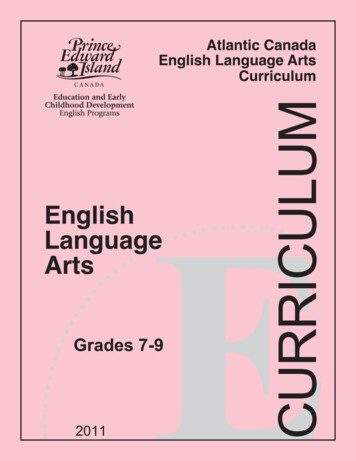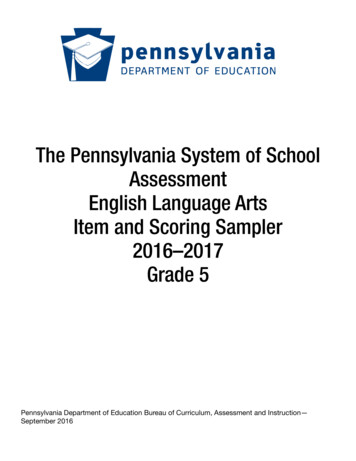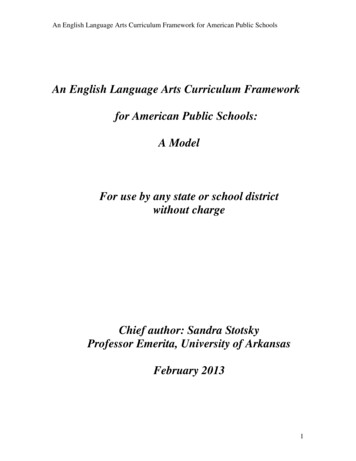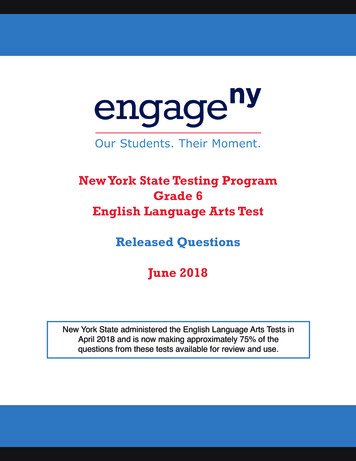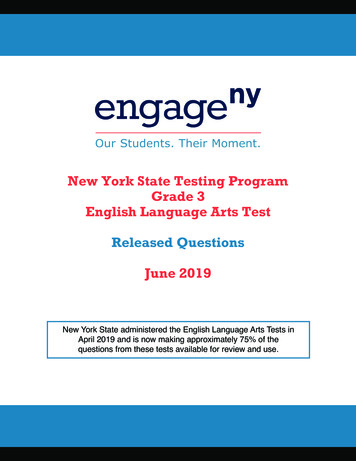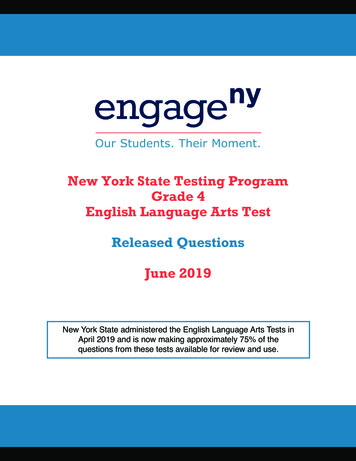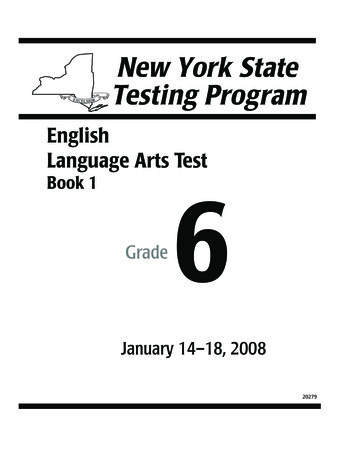
Transcription
EnglishLanguage Arts TestBook 1Grade6January 14–18, 200820279a20279 G6eBk1 OP 08NYS.indd 39/24/07 1:09:19 PM
TIPS FOR TAKING THE TESTHere are some suggestions to help you do your best: Be sure to read carefully all the directions in the test book. Plan your time. Read each question carefully and think about the answer before choosingyour response.Acknowledgments CTB/McGraw-Hill LLC is indebted to the following for permission to use material in this book:“Mira Sees the Light” by Leneh Trowbridge from Skipping Stones Magazine’s November/December 2004 issue, copyright 2004by Skipping Stones, Inc. Used by permission.Photograph of hatchling Loggerhead Turtles (Image No. JA007389), copyright by James L. Amos/Corbis. Used by permission.Photograph of Loggerhead Turtle hatchlings scramble for the surf (Image No. IH203640), copyright by Lynda Richardson/Corbis. Used by permission.“Native All-America” reprinted courtesy of Sports Illustrated for Kids from the June 2003 issue, text copyright 2003 byTime Inc., photograph by Eric Lars Bakke. Used by permission.“Galápagos Islands Vacation” by Melina Gerosa Bellows, tortoise photograph courtesy of Gleam Davis Prindle, from NationalGeographic Kids Magazine’s November 2005 issue, copyright 2005 by National Geographic Society. Used by permission.“Soccer Cinderella” by Monica A. Harris, copyright 2004 by CTB/McGraw-Hill LLC.“This Land Is Your Land” and photographs by Ashirah Knapp from New Moon Magazine’s July-August 2005 issue, copyright 2005by New Moon Publishing, Inc., Duluth, Minnesota. Used by permission.Developed and published by CTB/McGraw-Hill LLC, a subsidiary of The McGraw-Hill Companies, Inc., 20 Ryan Ranch Road, Monterey, California93940-5703. Copyright 2008 by New York State Education Department. All rights reserved. No part of this publication may be reproducedor distributed in any form or by any means, or stored in a database or retrieval system, without the prior written permission of New YorkState Education Department.a20279 G6eBk1 OP 08NYS.indd 49/24/07 1:09:19 PM
Book 1ReadingDirectionsIn this part of the test, you will do some reading and answer questions about whatyou have read.Go On SECURE MATERIAL Do not reproduce. Do not discuss contentsuntil end of designated makeup schedule.b20279 G6eBk1 OP 08NYS.indd 1Book 1Page19/24/07 1:09:24 PM
DirectionsRead this story. Then answer questions 1 through 7.Mira Sees the Lightby Leneh TrowbridgeOne warm September night, on the OuterBanks of North Carolina, soft sea breezes filledthe air. The moon was full. Mira could feel theenergy in the air. She felt something exciting wasgoing to happen. She loved everything about theocean, and this evening she had come down tothe beach to enjoy the salty night air and hearthe waves lapping gently against the sand.Mira closed her eyes and listened to thewaves. The gentle rolling sound was calming.Suddenly, Mira could hear another sound, too.She listened carefully. The sound was so faint shecould barely hear it. She held her breath. Thesound was still there.Scritch Scritch, Scratch . . . Scuffle Scuffle . . .Scritch Scritch, Scratch . . . Scuffle Scuffle . . .Mira opened her eyes and looked down at thesand. It was moving! All of a sudden she couldsee a tiny head poking out. Then, she saw fourtiny flippers and a shell. A turtle had emerged!Mira looked in amazement at the baby turtle.In the moonlight she could just make out thegreen and brown pattern on its quarter-sizedshell. It was so small! She looked closely and sawthat it had a little bitty beak with a sharp point.Mira watched with wonder as other babyturtles began to emerge. One by one theystruggled out of their underground nests. Soonthe beach was like a moving carpet of tiny turtles.Mira knew the turtles should head towards thewaves and swim away, so she was puzzled whenthey began to pull themselves towards the dunes.Why would the turtles be going away from theocean? Suddenly, she remembered something hergrandmother had told her.“Loggerhead sea turtles come back here everyyear, in April. They bury their eggs on the beachand in the first week of September those babyturtles hatch and head back down to the sea. Butsome of them never make it. Sometimes they diegoing across the dunes, trying to find those brightPage2b20279 G6eBk1 OP 08NYS.indd 2Book 1 SECURE MATERIAL Do not reproduce. Do not discuss contentsuntil end of designated makeup schedule.10/16/07 2:24:35 PM
lights on the houses. Every day there are morehouses being built on the dunes. That meansmore and more lights to confuse the sea turtles.”Mira looked out across the dunes at herhouse. It was a simple house with weatheredwooden shingles and a small back porch. Mirasaw her mother and father, sitting on the porchsipping lemonade and rocking her baby sister.She could see them because her house had twobright lights that lit up the porch.Mira began to run. She raced over thedunes and didn’t stop running until she reachedthe house.1They reached the beach just in time to see thetiny turtles slipping silently into the waves. Mirawatched as the last turtle entered the water. Asthe turtle swam away, it looked back at Mira. Inthe moonlight, Mira thought she saw it smile.enjoying the oceanturning lights off at nightsaving helpless animalslearning from grandparentsWhere does most of the story take place?ABCD3“Come and see!” she shouted. In a rush shewas off running down the dunes, with her wholefamily trailing behind her.This story is mainly aboutABCD2Her words came out in a frenzy, “The turtlesare hatching! We have to help the turtles!” Withthat, Mira ran into the house and turned off thebright porch lights.on a beach at nightin a house near the duneson a front porch in the eveningin the shallow water of the oceanWhy does Mira run to her house?ABCDto get a flashlightto turn off the porch lightsto ask her grandmother about the lightsto have some lemonade with her parents SECURE MATERIAL Do not reproduce. Do not discuss contentsuntil end of designated makeup schedule.b20279 G6eBk1 OP 08NYS.indd 3Book 1Go OnPage39/24/07 1:09:43 PM
4How does Mira know the lights confuse the turtles?ABCD5She read it in a book.Her grandmother told her.She learned about the turtles at school.Her parents taught her about the turtles.Read this sentence from the story.They reached the beach just in time to see the tiny turtles slipping silently into the waves.The phrases “tiny turtles” and “slipping silently” are examples ofABCD6How does Mira change during the story?ABCD7At first she is nervous, then she is confident.At first she is careful, then she is reckless.At first she is angry, then she is happy.At first she is calm, then she is excited.“Mira Sees the Light” is most 0279 G6eBk1 OP 08NYS.indd 4a folktalea mysteryrealistic fictionhistorical fictionBook 1 SECURE MATERIAL Do not reproduce. Do not discuss contentsuntil end of designated makeup schedule.9/24/07 1:09:43 PM
DirectionsRead this article. Then answer questions 8 through 12.Nadia Begay: Native All-Americanby Andrea N. WhittakerBasketball player Nadia Begay is a flash of inspiration across the New Mexico plains for thepeople of the Navajo Nation.Nadia Begay’s basketball career has been likea storm brewing in Kirtland, New Mexico. Itstarted quietly but has gained momentum andstrength each year.In March of 2003, the 5'8'' senior two-guardled Kirtland Central High School to its 15thstate championship. She scored a combined67 points in the semi-final and championshipgames and finished her prep career with 1,639points.You’d think that a school with 15 state titles(Kirtland has made the tournament 25 yearsin a row) would have sent a few players tobig-time colleges. But that September, Begaybecame the first KirtlandDivision 1 collegesplayer to be recruited by awith large athleticDivision 1 college straightprogramsfrom high school.Why? Begay is a Navajo Native American.Like many Native American players in thesouthwest, she has lived on or near reservationsher entire life. The areas are remote, so thereare few opportunities for a player to be seen bynational coaches.Begay will play hoops and study sportsmedicine at Boise State University on ascholarship. But she might not have beennoticed if it hadn’t been for her determinationto break through.Hoop DreamsBegay was born on a Navajo reservation inTuba City, Arizona. Her mother, Jackie, playedguard for Kirtland and is a former high schoolcoach. Growing up, Begay learned to playbasketball from her mom and always shot hoopsin the backyard. “There isn’t a house on thereservation that doesn’t have a basketball goal,”she says with a smile.Go On SECURE MATERIAL Do not reproduce. Do not discuss contentsuntil end of designated makeup schedule.b20279 G6eBk1 OP 08NYS.indd 5Book 1Page510/16/07 2:24:36 PM
Begay joined her first organized team infourth grade. By eighth grade, she had developeda smooth shooting stroke and made Kirtland’sjunior varsity team. She watched women’scollege games and thought, Man, I want to be onTV. I want to show I can play with them.her recruiting letters. She decided to attendBoise State after visiting the school.But she knew that college coaches weren’tgoing to come looking for her. “Kirtland is aone-stoplight town,” she says. “No Division 1coach would come down just to watchKirtland.”Boise’s guard-friendly system shouldcomplement Begay’s all-around scoring ability.In the opening minutes of the 2003 state final,Begay showcased her skills. She scored Kirtland’sfirst four baskets by splitting the defense for alayup, going coast-to-coast for a deuce, scoringon her own steal, and draining a corner jumper.She finished with 31 points in the 89–59 win.Opening the DoorIn 1995, Begay’s mother organized atraveling team. The team played in tournamentsin Oklahoma, Oregon, and Nevada. Playingin those tournaments helped the hardworkingguard with the sweet scoring touch grab theattention of Division 1 coaches.“She always talked about playing Division 1,”says friend Kym Simpson. “She worked hard,throughout the seasons and off-seasons. It paidoff.”Begay and her mom sent videotapes of herhighlights to Division 1 colleges around thecountry. By her sophomore year, schools such asSan Diego State, BYU, and Penn were sending8“I liked the campus, the coach is new, and Ithought I might fit there,” she says.Welcome to the ShowAfter the game, Begay signed autographs fora swarm of young Navajo girls. Those girls willsurely be tracking Begay’s college career. Somemay even follow her path.“I think [my recruitment] opens up a lotfor the Navajo Nation,” says Begay. “EveryDivision 1 coach I’ve talked to, I’m like, ‘Whydon’t you come check out this other player?’”And her plans for next season? “My goal isto start, but we’ll see,” she says. “I just hope tomake a difference.”According to the article, living on or neara Native American reservation made itdifficult for NadiaABCDto play basketball as a childto play on her high school teamto be noticed by national coachesto learn basketball from her motherThat’s one goal Begay has already achieved.9The information under the subheading“Hoop Dreams” is mainlyABCDPage6b20279 G6eBk1 OP 08NYS.indd 6Book 1a look back at Nadia’s start inbasketballa prediction about Nadia’s future inbasketballa summary of how Nadia received abasketball scholarshipan explanation of how Nadiaachieved her basketball goals SECURE MATERIAL Do not reproduce. Do not discuss contentsuntil end of designated makeup schedule.9/24/07 1:09:43 PM
10 Nadia Begay seems to believe that her recruitment by several Division 1 colleges willABCDcause more people to move to Kirtlandlead to opportunities for other Navajo athletesallow Kirtland to build a larger basketball gyminspire Navajo students to study sports medicine11 In the “Opening the Door” section of the article, Nadia’s friend, Kym Simpson, makessome comments. Based on the comments, it is reasonable to conclude that Nadia’s workhabits haveABCDallowed her to reach her lifelong goalbeen overshadowed by her great talentlet her relax after the basketball seasonprevented her from reaching her potential12 Which statement best explains why Nadia Begay is called a “flash of inspiration” to Navajos?ABCDNavajos know that Nadia learned to play basketball from her mom.Navajos know Nadia started playing basketball at a very young age.Navajo girls now believe they can earn an athletic scholarship to a major college.Navajo athletes now know they can help Kirtland Central High School win a state title.Go On SECURE MATERIAL Do not reproduce. Do not discuss contentsuntil end of designated makeup schedule.b20279 G6eBk1 OP 08NYS.indd 7Book 1Page79/24/07 1:09:43 PM
DirectionsRead this article. Then answer questions 13 through 16.Galápagos Islands Vacationby Melina Gerosa BellowsDozens of Pacific green sea turtles are slowlygliding by me as I snorkel along a rugged reef.Suddenly a snorkeler cuts me off. Then another.“Hey!” I think. “Watch where you’re going!”Then I realize: These aren’t snorkelers.They’re sea lions! Darting this way and that,the creatures blow bubbles at me and the groupof 11 kids I’m on vacation with. The sea lionsbonk us on our backs and swim off—only tozoom back for more.My name is Melina Gerosa Bellows. I’mthe editor in chief of National GeographicKids magazine. I took this amazing trip to theGalápagos Islands, a group of islands straddlingthe equator near Ecuador, in South America.My hotel was a yacht called the Eclipse thathad a pool and all the desserts we could eat.But the ship was nothing compared with theanimals I met.Jackson Prindle and a giant tortoiseZoo Without CagesHumans aren’t allowed to live on most of theGalápagos Islands. In fact, the only way you canexperience this magical place is by taking a smallmotorboat called a “panga” from your floatinghotel to all the islands. The lack of human threatmakes the animals very friendly. “The animals inthe Galápagos don’t know enough to be scaredof humans,” says our guide, Klaus Fielsch.The kids and I experience that firsthand.When we return to Santiago Island after oursnorkeling adventure, we discover two sea lionslying right next to our backpacks! To Fielsch, it’sno big deal. He walks right up to the giganticcreatures as if they are sunbathers and getsour stuff.Page8b20279 G6eBk1 OP 08NYS.indd 8Book 1 SECURE MATERIAL Do not reproduce. Do not discuss contentsuntil end of designated makeup schedule.10/17/07 11:35:20 AM
As we walk along the black sand formed frompulverized lava, we see even more wildlife. A furseal yelps for its mother. Bright red crabs clingto the rocks. Flashes of shiny black-and-whiteorcas splash in the distance.“The Galápagos Islands seem to break allthe rules of nature,” says 14-year-old Hannah,Harry’s sister. “You’ve got penguins on theequator, iguanas that can swim, and birds thatdon’t fly!”“We had to search to see any animalswhen we vacationed in the rain forest,” says12-year-old Harry Ashman of London, England,in the United Kingdom. “But here they’re justout in the open.”At the edge of a lagoon, we stop to watch afoot-long octopus. Suddenly a young sea lionpokes its head out of the water and pulls itselfonto the rock where 9-year-old Jackson Prindleof Santa Monica, California, sits. Like a dog,the sea lion curiously sniffs Jackson and thenbackflips into the water.Breaking the RulesThe following morning we again leave theEclipse on the panga. It bumps along the wavesuntil we reach Fernandina Island, known for itsvolcano.We walk along the hardened lava, whichlooks like dark-chocolate frosting. Black marineiguanas lounge1 on top of each other like tires ina junkyard. Flightless birds called cormorantsbuild their nests on the rocks. Nearby arewaddling Galápagos penguins. Standing about13 inches tall, they’re the second smallest speciesof penguin.As we ride the panga back to the Eclipse, sixpenguins on a rock stand like soldiers and seemto bid us goodbye. It is our last day, and none ofus wants to leave this special place. But we knowour trip to the Galápagos Islands has changedthe way we think about the world.“I’m really interested in saving theenvironment,” Hannah says. “More than ever,this trip makes me want to make sure theseanimals are kept safe.”1lounge: lie in a relaxed manner13 How does the author organize the article?ABCD14 A “panga” is important on a GalápagosShe explains a problem and how itis solved.She presents ideas in order of theirimportance.She compares a present situationwith one from the past.She describes an experience and itseffect on those involved.Islands trip because itABCDtransports visitors to each of theislandsprovides a place for visitors to stayat nightallows visitors to feed the animalsmore easilyprotects visitors who are snorkelingalong the reefsGo On SECURE MATERIAL Do not reproduce. Do not discuss contentsuntil end of designated makeup schedule.b20279 G6eBk1 OP 08NYS.indd 9Book 1Page99/24/07 1:09:44 PM
15 According to information in the article, watching animals on the Galápagos Islands isdifferent from watching animals in a rain forest because Galápagos Islands’ animals areABCDeasier to findmore numerousmore dangerousharder to approach16 After their vacation on the Galápagos Islands, the children in the group most likely believe thatABCDPagehumans should be allowed to live on more of the islandsthe rain forest is a more interesting place for humans to visithumans have a responsibility to protect the natural environmentthe animals on the islands need to be taught to stay away from humans10b20279 G6eBk1 OP 08NYS.indd 10Book 1 SECURE MATERIAL Do not reproduce. Do not discuss contentsuntil end of designated makeup schedule.9/24/07 1:09:44 PM
DirectionsRead this passage about a girl trying out for a soccer team. Then answer questions17 through 21.Soccer Cinderellaby Monica A. HarrisCindi sometimes felt different from her friends. She liked sports, baseball caps, and chewinggum, all things that her friends were definitely not interested in.In early spring, a flyer arrived in the mail. City Co-Ed Soccer Team Tryouts! Saturday only.This was it! A chance to be herself.Saturday seemed to take forever to arrive. “Soccer shoes, water bottle, sweatpants, and, oh,can’t forget my lucky cap,” Cindi said, packing her bag.As she parked her bike at the field, her heart sank. Her eyes searched from one end of the fieldto the other. “Please . . . oh please . . . let there be just one,” she thought. How could her luck be sobad? Of the 50 kids there, not one was a girl! Cindi felt as though she stuck out like a sore thumb.“Time for Plan B,” she sighed, and darted behind the concession stand. She pulled on thesweatpants and tucked her hair up into her cap. Her heart raced as she tied her shoes. “Calmdown,” she thought, “just try to blend in.” Keeping her head down, she walked over to the field.The coach’s assistant handed out numbers to wear. “13, just perfect,” Cindi sighed.The first tryout drills divulged Cindi’s many talents. Cindi dribbled the ball with ease, ranthe fastest through the footwork obstacle course, and made passes that were always on target.“Nice work, 13,” the assistant said. Cindi was thrilled.For the final tryout, the kids were to kick the ball past the goalie. He was the star of last year’steam and was tough to beat. When Cindi faked to the left, the goalie moved in for the block, butshe wheeled around and shot to the right. Goal! The coach jotted something on his clipboard.Each player made several attempts. A few of the boys got the ball past him, but Cindi scoredevery time. On the final round of shots, Cindi decided to try a direct kick over his head.Unknown to her, someone had stepped on her shoelace, and it was now untied. As she madethe final kick, not only did the ball go flying into the net, but it was followed by her shoe! Allthe kids laughed and pointed. The assistant let out a cheer, “Double goal!”Cindi was horrified! As she felt the tears begin to pool in her eyes, she ran to her bike. She rodehome as fast as she could. Her tears blurred her vision, and her heart felt like stone. Cindi ranthrough the front door and scrambled up the stairs to her room. She threw herself on the bed.A few hours had passed when there was a knock at the door. Her mother called her to comedownstairs. “What now?” she wondered. As she rounded the corner, she came face to face withthe soccer coach and his assistant. Her heart skipped a beat.Go On SECURE MATERIAL Do not reproduce. Do not discuss contentsuntil end of designated makeup schedule.b20279 G6eBk1 OP 08NYS.indd 11Book 1Page119/24/07 1:09:44 PM
“Hi Cindi. I believe I have something that belongs to you,” the coach said,slowly pulling her shoe from behind his back.“Sorry, I’ve never seen that shoe before,” Cindi lied.“That’s funny. It has ‘C. Rella’ written in it. You are Cindi, aren’t you?”“Yeah,” she answered, “but that’s not my shoe.”“Well, then it won’t hurt to try it on,” the assistant said.Cindi rolled her eyes and sat down on the chair. She arched her foot as they tried it on, butluck wasn’t on her side. The shoe slipped on with ease and seemed to hug her foot perfectly.“Okay, it’s mine,” she said while taking it off. “I’m sorry. I guess I shouldn’t have beenthere today.”“First of all,” the coach said, “you had every right to be at the tryouts. The team is co-ed,which means it’s open to boys and girls. Unfortunately, we haven’t had any girls show up . . .until now.”The coach knelt down so that he could see Cindi’s face. “We came by to ask you if you’dlike to play on the team. You have a lot of talent, and we could use your help getting to thechampionship this year.”Cindi was shocked. This was it! A chance to be herself. “I’d be honored,” she answeredwith a bow.18 Read this sentence from the passage.17 Why is Cindi disappointed when shearrives at the soccer field?ABCDPageNone of her friends are there.There are only boys trying out.The players are bigger than she is.There are too many kids trying out.12b20279 G6eBk1 OP 08NYS.indd 12Book 1Cindi felt as though she stuck outlike a sore thumb.Which phrase best explains how Cindifelt?Aconcerned about playing with aninjuryBunsure that she could play wellenoughCconfused as to how to change herclothes quicklyDuneasy about being different fromthe other players SECURE MATERIAL Do not reproduce. Do not discuss contentsuntil end of designated makeup schedule.9/24/07 1:09:44 PM
19 When Cindi says, “Time for Plan B,” it means that she plans toABCDtry to look like a boytry to get a different numberkick the ball over the goalie’s headask her friends to try out for the team20 Which words best describe Cindi’s emotions at the soccer field before and right after thetryouts?ABCDsad, then delightednervous, then upsetscared, then amusedconfident, then angry21 Read these sentences from the passage.The first tryout drills divulged Cindi’s many talents. Cindi dribbled the ball with ease,ran the fastest through the footwork obstacle course, and made passes that were alwayson target.In the first sentence, what does “divulged” mean?ABCDexhaustedlimitedrepairedrevealedGo On SECURE MATERIAL Do not reproduce. Do not discuss contentsuntil end of designated makeup schedule.b20279 G6eBk1 OP 08NYS.indd 13Book 1Page139/24/07 1:09:45 PM
DirectionsRead this article. Then answer questions 22 through 26.This Land Is Your Landby Ashirah KnappI used to think that the only way to get foodand clothes was to buy them. And I thought theonly people who lived off the land were NativeAmericans of the past. Now, at the age of 26, Ican happily say that’s not true! I live in Maine ina house my husband and I built. We grow mostof our own food, provide our own electricity, andsew our own clothes. It’s fun to live off the land.We provide for ourselves and we know where ourfood and other materials come from. I even sewedmy wedding dress out of hand-tanned buckskin.We live in a log cabin made from trees that wecut down ourselves (one by one) and carried onour shoulders to the building site. The trees wepicked had blown over or were sick. We left thehealthy trees to keep growing. With help fromfriends, we built our home in only two monthsand we had lots of fun!Our water comes from an undergroundspring. The water is so cold that we use it like arefrigerator and put containers of food in it tokeep them from spoiling.We also use some things from the modernworld because our life is about learning fromeveryone—using both old and new ways—tocreate a healthy plan for living on earth. Ourelectricity comes from two solar panels.1Our way of life is also our job. We lead tripsfor a wilderness education school in Vermontcalled Kroka Expeditions. On the trips we teachpeople about living on the land. We teach themhow to build fires, collect wild plants to eat,identify animal tracks, build shelters, find dryfirewood in the rain, and cook over a fire. It givespeople such a good feeling when they see theycan care for themselves in the most basic ways.By learning to live on the land I hope peopleappreciate the earth’s resources and want to usethem responsibly.1Ashirah Knapp and her husband in front of theirlog home.Page14b20279 G6eBk1 OP 08NYS.indd 14solar panels: large panels used to absorb sunlight,whose energy can be stored in batteries and used tomake electricityBook 1 SECURE MATERIAL Do not reproduce. Do not discuss contentsuntil end of designated makeup schedule.10/16/07 2:24:38 PM
A Day in the Life (of me!)6:30 Get up.6:30–7:00 Stretch, do strengthening exercises, and gooutside to greet the day.7:00 Eat breakfast.7:30 or 8:00 Morning chores (sweep the cabin, fill thewoodbox, split kindling, empty the compost bucket intothe compost pile, and haul water from the spring).9:00 The main morning work, which changes with theseason: lately, we’ve been cutting sick or dying treesinto logs and pulling them out of the woods on ourwood-hauling sled. In the spring, we’ll saw them intoboards for building projects.12:00–1:00 Lunch1:00–1:30 Practice guitar.1:30–2:00 More stretching.2:00–3:30 Office work, return phone calls and answer mail.3:30–5:30 Cut firewood, weed garden, or go for a jog.5:30–6:30 Clean up projects, put away tools, preparesupper.6:30 Supper7:30 Sew patches on clothes, read, write, indoor craftprojects.9:30 or 10:00 Bedtime!23 How do the Knapps use a nearby spring22 How does the information in the boxto save electricity?“A Day in the Life (of me!)” help thereader understand the article?AAIt explains how the Knapps earna living.They use the water to refrigeratefood.BBIt gives details about the daily tasksof living off the land.They warm the water in the sunfor bathing.CCIt gives instructions on how toperform important chores.They run the water through thesolar panels.DDIt outlines the exercise programneeded to live in this way.They use the water to cool theelectrical battery.Go On SECURE MATERIAL Do not reproduce. Do not discuss contentsuntil end of designated makeup schedule.b20279 G6eBk1 OP 08NYS.indd 15Book 1Page1510/16/07 2:24:38 PM
24 How is the Knapps’ home an example of “living off the land”?ABCDThey lived in the cabin while it was being built.They made the cabin out of wood their friends provided.They cut down trees from their land to get wood to build their cabin.They earned money to build the cabin by teaching wilderness classes.25 Which sentence from the article expresses an opinion?ABCD“It’s fun to live off the land.”“We live in a log cabin.”“Our water comes from an underground spring.”“Our electricity comes from two solar panels.”26 The most important lesson that Ashirah hopes people learn from her isABCDhow to collect wild plants safelyhow to identify animal tracks quicklyhow to use natural resources responsiblyhow to treat other wilderness visitors respectfullySTOPPage16b20279 G6eBk1 OP 08NYS.indd 16Book 1 SECURE MATERIAL Do not reproduce. Do not discuss contentsuntil end of designated makeup schedule.9/24/07 1:09:45 PM
b20279 G6eBk1 OP 08NYS.indd 179/24/07 1:09:45 PM
Grade 6English Language Arts TestBook 1January 14–18, 2008a20279 G6eBk1 OP 08NYS.indd 29/24/07 1:09:10 PM
Jan 14, 2008 · bright lights that lit up the porch. Mira began to run. She raced over the dunes and didn’t stop running until she reached the house. Her words came out in a frenzy, “The turtles are hatching! We have to help the turtles!” With that, Mira ran into the house and turned off the bright porch li

